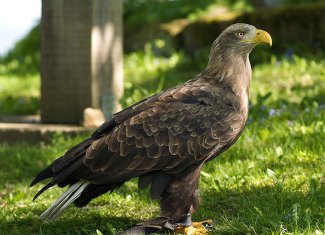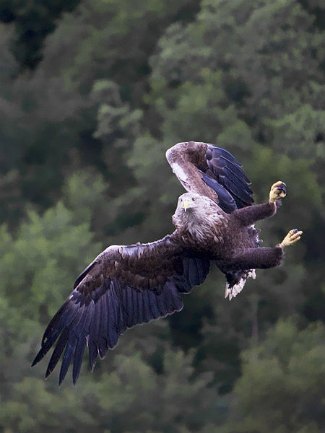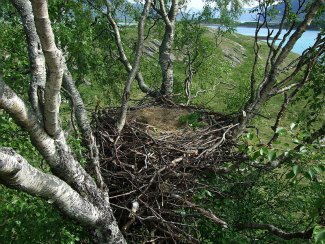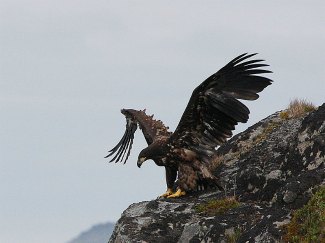White-Tailed Eagle - Haliaeetus albicilla
By Jörg Hempel, CC-BY-SA-3.0-de, via Wikimedia Commons
Family: Accipitridae
Genus: Haliaeetus
Species: H. albicilla
White-Tailed Eagles are the largest raptors in Europe and inhabit a range that spans Greenland to southern China. They form a clade with H. leucocephalus (Bald Eagle), H. leucoryphus (Pallas's Fish Eagle), and H. pelagicus (Steller's Sea Eagle). They are also a sister species to H. leucocephalus.
Physical Description:
White-Tailed Eagles are almost entirely brown. They have a yellow-gray head, neck, breast, and lesser wing coverts, and the belly, thighs, and rump are dark brown. The flight feathers are close to black and their wedge-shaped tail, as their name would indicate, is white. The tibia are feathered, though the tarsi are not, and the legs and feet are yellow. The eyes, beak, and cere are yellow.
Juveniles are dark brown to black with white lores, a pale throat, and an off-white tail with a dark tip and mottling. The underparts are buff-brown with variable streaks and spotting and the feather bases are white. Eyes are dark brown and the cere and beak are yellow-brown. Juveniles reach full adult plumage after 5-6 years.
White-Tailed Eagles are noisy at the beginning of the breeding season, during courtship. They call from a perch or in flight, and their main call is a series of short yelps repeated 15-30 times. Females are lower-pitched than males. Listen to a recording.
Their maximum lifespan is 36 years in the wild and up to 50 in captivity.
By Carol Carpenter, CC-BY-2.0, via Wikimedia Commons
Size:
Length: 74-92 cm
Wingspan: 193-244 cm
Weight: Male: 3.1-5.4 kg. Female: 3.7-6.9 kg.
Habitat and Distribution:
They live in a wide range of habitats, though they are most commonly found close to water and in lowlands. They have been recorded in estuaries, coastal marshes, cliffs, islands and archipelagos, forest, grassland, tundra, taiga, lakes, and wetlands, from 0-5,000 m above sea level.
White-Tailed Eagles are widely distributed across Europe, the Middle East, and Asia, from 74°N to 30°N in summer and below 22°N in winter. They occur in southwestern Greenland and western Iceland to northern and eastern Europe, western Europe and the Persian Gulf, Pakistan and northern India, southern China, and Japan; they also live through Manchuria and Russia. Adults are partial migrants, moving south in August-September and returning in March-April. They winter in southern Europe, the Indian subcontinent, Korea, Japan, and southeast China. Juveniles disperse from breeding areas and tend to be more migratory than adults. There are an estimated 20,000-39,600 individuals over a range of 18,600,000 km².
Diet and Hunting:
A large variety of animals have been recorded in their diet, and they are known to eat fish, birds, mammals, carrion, and offal. Fish constitute a majority of their diet in some areas. Avian prey includes grebes, ducks, coots, geese, swans, cormorants, partridges, pheasants, and nestlings, the last of which to such an extent that some bird populations have moved to avoid predation by White-Tailed Eagles. They eat mammals such as voles, sheep, deer calves, hares, arctic foxes, and muskrats; even roe deer have been recorded on occasion.
They hunt fish by snatching them from the water close to the surface after a dive, wading in shallow water, following fishing boats, or exploiting commercial fisheries. White-Tailed Eagles are known to hunt cooperatively, sometimes in pairs or groups of older and younger birds. Like many eagles, they are kleptoparasites and will steal food from other birds, raptors or non-raptors.
Reproduction:
Breeding displays consist of soaring, cartweeling, sky dances, and loud calling. The breeding season is from January-June in the southern part of their range and April-September in the north. Pairs are monogamous and will return to the same nest sites year after year, though they may have up to 2-3 nest sites per territority.
By Finn Rindahl, CC-BY-SA-3.0, via Wikimedia Commons
The nest is built out of branches and sticks and is usually 1 m across and 2 m deep, growing to be several meters in size after consecutive use. It is lined with moss, green vegetation, seaweed, or wool and placed 10-20 m above the ground in a tree or up to 75 m high on a cliff, usually close to water. 1-3, usually 2, white and unmarked eggs are laid, which measure 75 by 58 mm and weigh 142 g. They are incubated by both parents for 34-46 days. Fledging takes 70-90 days and the young are dependent on their parents for 30-40 days after that. White-Tailed Eagles are sexually mature after about 5 years, though only 30-40% of fledged young will survive through their first winter.
Conservation:
They were downlisted from Near Threatened to Least Concern by BirdLife International in 2005. The population has been increasing since the 1970s and programs have been successful in reintroducing the eagles to areas where they had been forced into extinction, such as Great Britain. However, there are still ongoing threats such as habitat loss, shooting, poisoning, wind turbine collisions, pollution, and pesticides (though DDT has been banned in many areas).
Taxonomy:
Haliaeetus albicilla forms a clade with H. leucocephalus (Bald Eagle), H. leucoryphus (Pallas's Fish Eagle), and H. pelagicus (Steller's Sea Eagle). H. albicilla is also a sister species to H. leucocephalus. Molecular studies have shown that genus Haliaeetus is closely related to the kite genera Milvus and Haliastur.
The scientific binomial name Haliaeetus albicilla comes from the Greek halos meaning "the sea" and aetos for "eagle", in addition to the Latin albus for "white" and cilla for "tail".
Subspecies:
The part of the population found in Greenland is sometimes considered as subspecies H. a. groenlandicus, but since several authorities no longer recognize it, it is ignored on this website.
Other Names:
Erne, Eurasian Sea Eagle, Gray Sea Eagle, Sea Eagle, White-Tailed Fish Eagle, White-Tailed Erne, White-Tailed Sea Eagle, Shqiponja e detit (Albanian), Havørn (Danish), Zeearend (Dutch), Merikotka (Finnish), Pygargue à queue blanche (French), Seeadler (German), Haförn (Icelandic), Iolair Mara (Irish), Aquila di mare codabianca (Italian), Orjirowashi (Japanese), Bielik zwyczajny (Polish), Orao belorepan (Serbian), Pigargo Coliblanco, Pigargo Europeo (Spanish), Havsörn (Swedish), Ak kuyruklu Kartal (Turkish), Eryr cynffon wen, Eryr gynffonwen (Welsh).
Video of a White-Tailed Eagle Nest:
References:
http://www.arkive.org/white-tailed-eagle/haliaeetus-albicilla/
http://avibase.bsc-eoc.org/species.jsp?avibaseid=5A3D91D3254A568D
http://www.avibirds.com/euhtml/White-Tailed_Eagle.html
BirdLife International (2012) Species factsheet: Haliaeetus albicilla. Downloaded from http://www.birdlife.org on
22/04/2012.
http://blx1.bto.org/birdfacts/results/bob2430.htm
http://www.europeanraptors.org/raptors/white_tailed_eagle.html
http://www.forestry.gov.uk/forestry/white-tailedeagle
Global Raptor Information Network. 2012. Species account: White-tailed Eagle Haliaeetus albicilla. Downloaded from
http://www.globalraptors.org on 22 Apr. 2012
http://www.goldeneagle.ie/portal.php?z=9
http://www.hawkandowl.org/Species/DiurnalBirdsofPrey/White-tailedEagle
http://ibc.lynxeds.com/species/white-tailed-sea-eagle-haliaeetus-albicilla
http://identify.whatbird.com/obj/1097/overview/White-tailed_Eagle.aspx
BirdLife International 2009. Haliaeetus albicilla. In: IUCN 2011. IUCN Red List of Threatened Species. Version 2011.2.
www.iucnredlist.org. Downloaded on 22 April 2012.
http://www.planetofbirds.com/accipitriformes-accipitridae-white-tailed-eagle-haliaeetus-albicilla
Ferguson-Lees, James, and Christie, David A. Raptors of the World. Houghton Mifflin Company, 2001.
http://www.rspb.org.uk/wildlife/birdguide/name/w/whitetailedeagle/index.aspx



